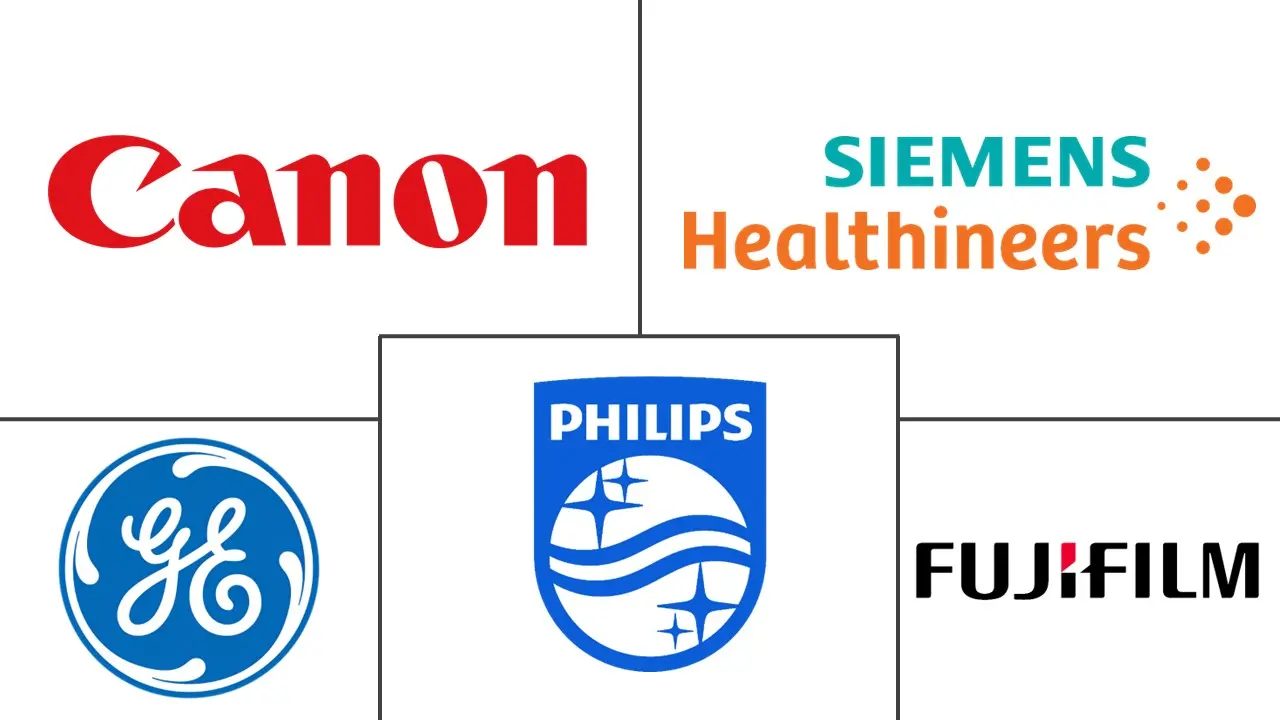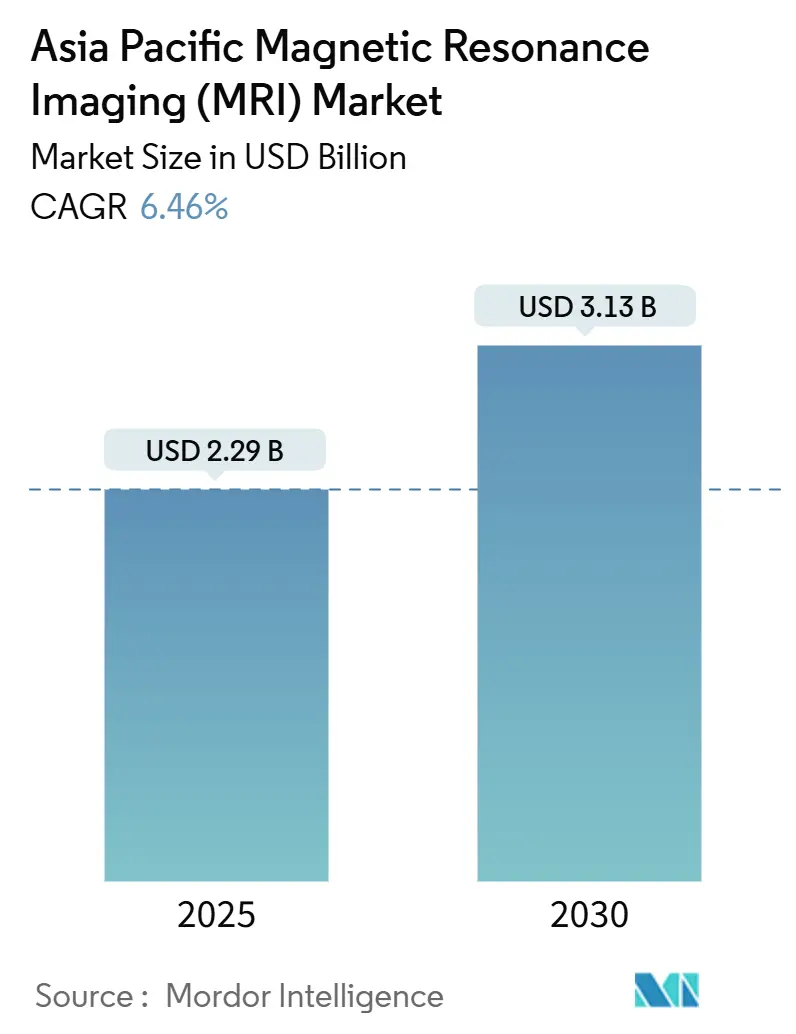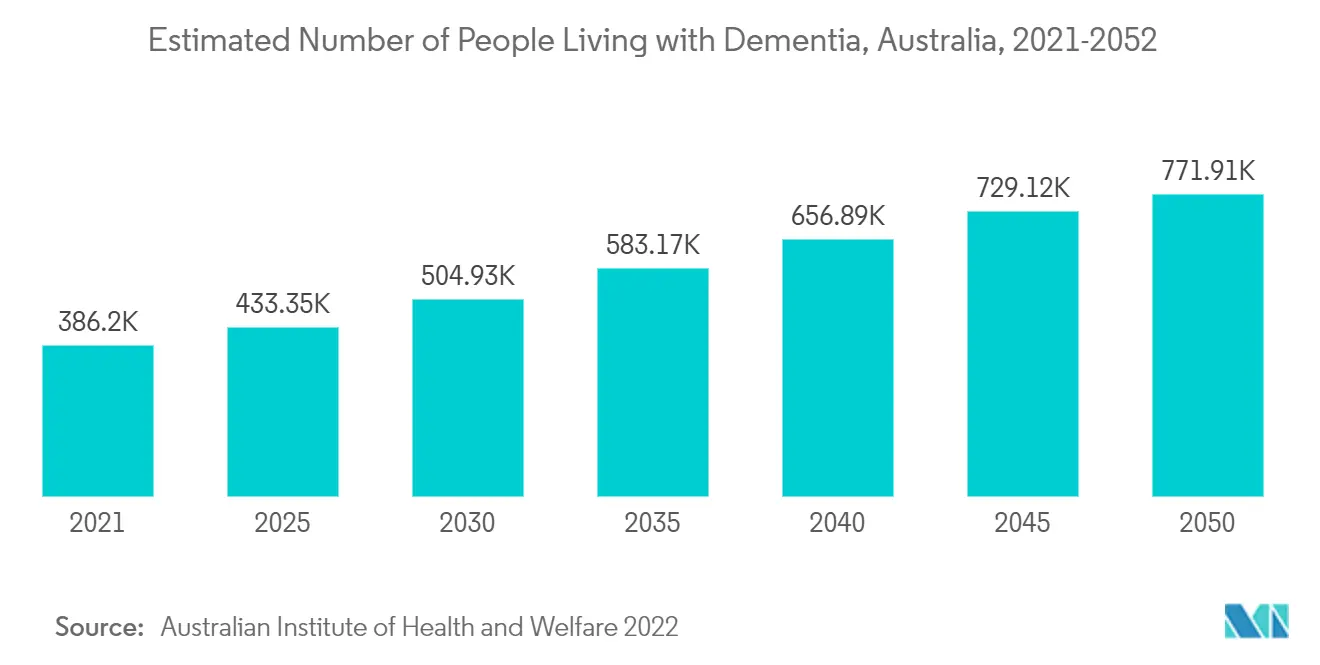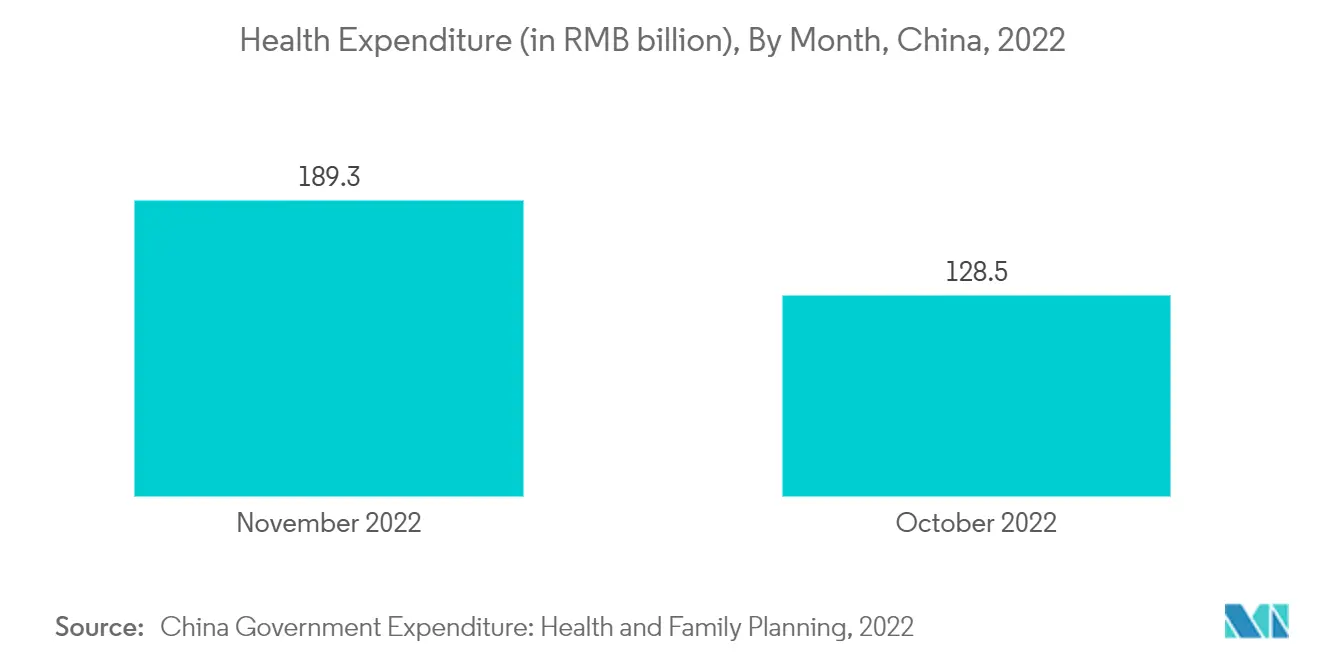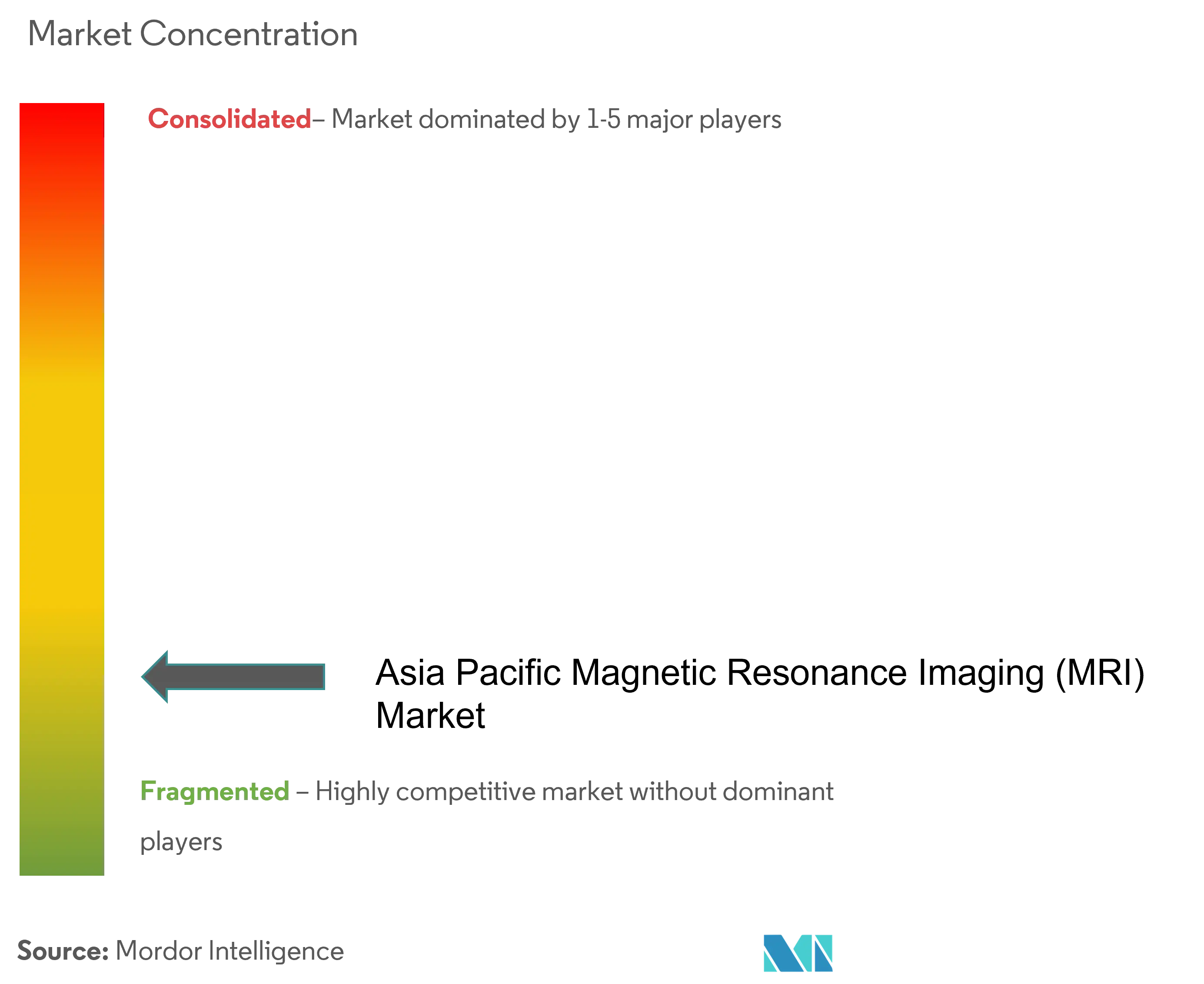Asia Pacific MRI Market Analysis
The Asia Pacific Magnetic Resonance Imaging Market size is estimated at USD 2.29 billion in 2025, and is expected to reach USD 3.13 billion by 2030, at a CAGR of 6.46% during the forecast period (2025-2030).
During the early pandemic, due to lockdown restrictions, suspension of non-urgent scheduled visits and hospitalizations, and stringent social distancing norms, the demand for MRI imaging was reduced, which affected the market studied. As per the article published by the National Institute of Health in January 2021, the radiology services in India were majorly damaged during the COVID-19 pandemic, and hospital systems were largely affected. However, post-pandemic, the market is expected to gain traction over the coming years because of declining COVID-19 cases and the resumption of hospital services and MRI imaging.
The market is driven by the rising prevalence of chronic diseases in the country. With the increasing burden of chronic diseases, such as cancer and cardiovascular diseases, coupled with the technological advancements in the country, the magnetic resonance imaging (MRI) market is expected to grow in the region. For instance, according to the study published in the Chinese Medical Journal in March 2022, in China, there were about 4,820,000 cancer cases and 3,210,000 cancer deaths in 2022. Lung cancer is the most prevalent cancer in China and the leading cause of cancer death. In China, age-standardized incidence and mortality rates have increased. Thus, the country's significant burden of cancer is expected to boost the market over the forecast period.
Additionally, the availability of universal health coverage in several Asian countries is expected to boost market growth over the forecast period. For instance, as per World Bank data published in October 2021, to ensure that their populations can access the healthcare they require without experiencing financial hardship, the World Bank has assisted nations throughout East Asia and the Pacific in their efforts to improve health services. Results-based financing based on disbursement-linked indicators (DLIs) is proving a valuable tool, helping maintain momentum towards universal health coverage (UHC) in the region. East Asian and Pacific Island nations have committed to offering their citizens universal health coverage so they may get the high-quality care they need when they need it without facing financial hardship.
Factors such as the increasing adoption of MRI coupled with initiatives by public and private organizations are expected to increase the market's growth. For instance, in January 2021, Promaxo Inc., the medical imaging, robotics, and AI technology company, and Huami Corp. closed an investment round of USD 4.17 million led by Huami. The Huami Corporation made a strategic investment in Promax, Inc. to develop powerful open MRI systems that provide better healthcare to patients and clinical settings. Similarly, in May 2021, the government of Andhra Pradesh launched CT and MRI scanners in four hospitals located in Ongole, Kadapa, Srikakulam, and Nellore. Therefore, due to the above-mentioned factors, the magnetic resonance market is expected to grow during the forecast period.
Hence, with the above-mentioned factors, it is observed that increasing awareness regarding MRI scans is propelling the growth of the MRI services market across the Asia-Pacific region. However, the high cost of the MRI system may hamper the market growth.
Asia Pacific MRI Market Trends
Neurology Segment is Expected to Hold Major Market Share and is Believed to Continue the Same Over the Forecast period
Magnetic resonance imaging (MRI) is the best diagnostic and neuroscience research tool. It provides morphological images with the highest spatial resolution, unmatched soft tissue contrast, and unique functional information about the central nervous system (CNS). MRI can detect disorders as well as monitor degenerative diseases like multiple sclerosis, Alzheimer's disease, and dementia, and it can even document brain injury from trauma. For instance, as per the Australian Institutes of Health and Welfare report published in September 2022, between 386,200 and 487,500 Australians were predicted to have dementia in 2022. This equates to 15 cases of dementia per 1,000 Australians, which rises to 83 cases per 1,000 Australians aged 65 and above. In Australia, women make up about two-thirds of dementia patients. Thus, increasing cases of dementia in the future will create a demand for MRI scans in Australia and will contribute to market growth.
Moreover, major players are strategically introducing new innovative technologies into MRI products for improved prediction of brain disorders. For instance, in November 2021, in Japan, Canon Medical launched the Vantage Fortian, a new advanced productivity, open-bore 1.5T MRI system, at RSNA 2021. The new system features innovative workflow solutions, image enhancement, and accelerated scan technology. It used AI smart technologies, machine learning, and deep learning technology to enhance image quality by removing noise and restoring SNR. Thus, this new MRI technology is expected to increase the demand for the studied segment in the future.
Furthermore, in December 2021, Canon Medical Systems Corp. signed a licensing arrangement with Resoundant Inc. to include its technology in Canon's newest line of magnetic resonance imaging. Although research is underway to use Resoundant's MRE technology to scan other soft organs and brains. Hence, the use of MRI is expected to increase in the coming years in the diagnosis of the disease, which will drive the segment shortly.
China is Expected to Hold a Significant Market Share Over the Forecast Period
Factors such as the increasing burden of chronic diseases, growing healthcare spending, and initiatives by key market players are expected to increase market growth. China has one of the country's highest burdens of chronic diseases, such as cancer, which are expected to drive the development of the studied market over the years. CVD is one of China's greatest healthcare burdens, according to a study published in the International Journal of Public Health in April 2022. In 2021, there will be 290 million people in China suffering from cardiac disorders (13 million), stroke, coronary heart disease (11 million), rheumatic heart disease (2.5 million), heart failure (4.5 million), congenital heart disease (2 million), pulmonary heart disease (5 million), and hypertension (245 million). Thus, the growing prevalence of chronic diseases is expected to boost demand for MRI devices, thereby boosting the market growth.
Product launches are another factor in market growth. For example, in August 2021, Siemens Shenzhen Magnetic Resonance Ltd (SSMR), a wholly owned subsidiary of Siemens Healthineers, introduced to the Chinese market a high-end magnetic resonance (MR) scanner powered by artificial intelligence, the 1.5 Tesla (1.5T) MAGNETOM Altea. Similarly, in July 2021, Neusoft Medical launched NeuMR Libra MRI at the China International Medical Equipment Fair in Shanghai. Thus, the abovementioned factors, such as the growing burden of chronic diseases and product launches, are expected to increase the market growth.
Asia Pacific MRI Industry Overview
The Asia-Pacific magnetic resonance imaging (MRI) market is highly competitive and consists of several major players. In terms of market share, few of the major players currently dominate the market. However, with technological advancement and quality service provision, mid-size to smaller companies are increasing their market presence by introducing new products at fewer prices. Some of the companies involved in the market are Siemens Healthcare, GE Healthcare, Canon Medical Systems Corporation, Koninklijke Philips NV, Fujifilm Corporation, Esaote SpA, and Neusoft Medical Systems Co. Ltd.
Asia Pacific MRI Market Leaders
-
Siemens Healthcare
-
Canon Medical Systems Corporation
-
Koninklijke Philips NV
-
GE Healthcare
-
Fujifilm Corporation
- *Disclaimer: Major Players sorted in no particular order
Asia Pacific MRI Market News
- March 2022: Siemens installed its MRI Scanner at North Eastern Community Hospital in the Benson Radiology department in South Australia.
- March 2022: Siemens Healthineers introduced its unique solutions in MRI MAGNETOM FreeStar at the 74th National Conference, IRIA 2022, Bengaluru, India.
Asia Pacific MRI Industry Segmentation
As per the scope of the report, magnetic resonance imaging is a medical imaging technique that is used in radiology to produce pictures of the anatomy and the physiological processes of the body in both health and disease. These pictures are further used to diagnose and detect the presence of abnormalities in the body. The Asia-Pacific Magnetic Resonance Imaging (MRI) Market is Segmented by Architecture (Closed MRI Systems and Open MRI Systems), Field Strength (Low Field MRI Systems, High Field MRI Systems, and Very High Field MRI Systems and Ultra-high MRI Systems), Application (Oncology, Neurology, Cardiology, Gastroenterology, Musculoskeletal, and Other Applications), and Geography (China, Japan, India, Australia, South Korea, and Rest of Asia-Pacific). The report offers the value (in USD million) for the above segments.
| By Architecture | Closed MRI Systems |
| Open MRI Systems | |
| By Field Strength | Low Field MRI Systems |
| High Field MRI Systems | |
| Very High Field MRI Systems and Ultra-high MRI Systems | |
| By Application | Oncology |
| Neurology | |
| Cardiology | |
| Gastroenterology | |
| Musculoskeletal | |
| Other Applications | |
| Geography | China |
| Japan | |
| India | |
| Australia | |
| South Korea | |
| Rest of Asia-Pacific |
Asia Pacific Magnetic Resonance Imaging Market Research FAQs
How big is the Asia Pacific Magnetic Resonance Imaging (MRI) Market?
The Asia Pacific Magnetic Resonance Imaging (MRI) Market size is expected to reach USD 2.29 billion in 2025 and grow at a CAGR of 6.46% to reach USD 3.13 billion by 2030.
What is the current Asia Pacific Magnetic Resonance Imaging (MRI) Market size?
In 2025, the Asia Pacific Magnetic Resonance Imaging (MRI) Market size is expected to reach USD 2.29 billion.
Who are the key players in Asia Pacific Magnetic Resonance Imaging (MRI) Market?
Siemens Healthcare, Canon Medical Systems Corporation, Koninklijke Philips NV, GE Healthcare and Fujifilm Corporation are the major companies operating in the Asia Pacific Magnetic Resonance Imaging (MRI) Market.
What years does this Asia Pacific Magnetic Resonance Imaging (MRI) Market cover, and what was the market size in 2024?
In 2024, the Asia Pacific Magnetic Resonance Imaging (MRI) Market size was estimated at USD 2.14 billion. The report covers the Asia Pacific Magnetic Resonance Imaging (MRI) Market historical market size for years: 2019, 2020, 2021, 2022, 2023 and 2024. The report also forecasts the Asia Pacific Magnetic Resonance Imaging (MRI) Market size for years: 2025, 2026, 2027, 2028, 2029 and 2030.
Our Best Selling Reports
Asia Pacific MRI Industry Report
Statistics for the 2025 Asia Pacific Magnetic Resonance Imaging (MRI) market share, size and revenue growth rate, created by Mordor Intelligence™ Industry Reports. Asia Pacific Magnetic Resonance Imaging (MRI) analysis includes a market forecast outlook for 2025 to 2030 and historical overview. Get a sample of this industry analysis as a free report PDF download.

